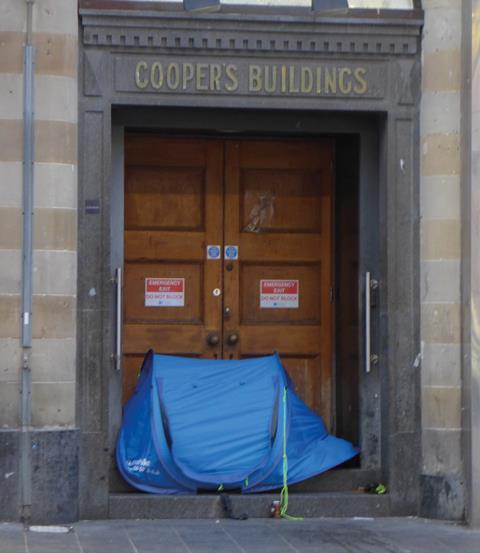The city’s housing and homelessness crisis is not just a consequence of austerity. Government at both local and national level is failing in its legal duties to vulnerable people, reports Eduardo Reyes
Arrive from the south-east of England, which has a lacklustre way with municipal grandeur, and the exit from Liverpool Lime Street station stops you in your tracks. The land falls away to classical St George’s Hall, with formal gardens behind and the Walker Art Gallery beyond. There’s a 10-storey Victorian railway hotel to the right, and to the left, an Edwardian spectacular – the world-famous Adelphi.
In front as I descend broad steps is a ‘rough sleeper’, sitting in his sleeping bag, who tells anyone who asks how he is about a recent operation – a skin graft. It is the start of evening rush hour, and on the 10-minute walk to a hotel on Hanover Street, I see another 11 rough sleepers – in, on or by tents and/or sleeping bags.
Liverpool City Council, which as a local authority has legal duties on housing and homelessness, claims to take 30 rough sleepers off the streets every night.
Two mornings later, there are 13 on the same stretch. Further towards Albert Dock on Paradise Street, a stretch of high-end retail flanked by the guarded spaces of yet more exclusive shops, one tent has a wheelchair tethered to its side. And it is cold. Stand in front of the council’s offices – in the old Cunard Building – and the wind cuts straight through you.
Scale of priority
Notionally, every rough sleeper seen in Liverpool scores from one to five on a sliding scale of priority needs and vulnerability used by the city council and agencies it engages to assist it.
‘In general I don’t like “priority needs” as a concept – the idea that someone is fit to be on the streets,’ local GP Dr Ryan Young tells me. ‘They all have vulnerabilities from their route into homelessness.’

I am not here on a hunch. There are understood to be just four legal aid housing law solicitors left acting for claimants – tenants and the homeless – in the entire Liverpool area, down from six in the last year. One got in touch.
‘You may have heard that Liverpool has been shown to be facing the largest increase in homelessness costs in the UK,’ Vauxhall Law Centre’s (VLC) Siobhan Taylor-Ward told me. There was, she said, ‘a terrible situation already, locally, as a result of a basically failed homelessness department at Liverpool City Council’.
Meanwhile, the Home Office, keen to clear its controversial backlog of asylum claims, has been speeding through categories of applicant it knows are most likely to get a positive decision on refugee status. Once in receipt of a positive decision, an asylum applicant’s Home Office support for accommodation will end with 28 days’ notice. Local authorities then assume responsibility for them. Serco, working for the Home Office to provide dispersal accommodation, gives the council notice of that transfer of responsibilities. From August to November last year, typically just seven days’ notice.
'In general I don’t like ‘priority needs’ as a concept – the idea that someone is fit to be on the streets. They all have vulnerabilities from their route into homelessness'
Dr Ryan Young
Homeless refugees are also now among the VLC’s clients. ‘Liverpool is the largest dispersal area for asylum seekers outside London,’ Taylor-Ward continued. ‘We are dealing with an avalanche of refugee homelessness on top of an already unmanageable situation.’
Vauxhall, north of Liverpool’s city centre, was always a working-class area. But now proximity to the centre has increased property prices – without removing any of the other challenges its residents face. Section 21 ‘no-fault evictions’ are common as rents rise.
That much I knew from conversations with Taylor-Ward two years ago. But VLC is now grappling with the problems of a wider catchment. Law Society research charts the decline in Liverpool’s housing legal aid providers: nine in 2019; eight in 2022; five in 2023. Since those figures were compiled, Broudie Jackson Canter has ceased housing legal aid work – team members moved to Capsticks, which acts for landlords and not tenants.
Now there are four: VLC, Merseyside Law Centre, Shelter and James Murray Solicitors. Of these, only the law centres also have a legal aid contract for social benefits work, though in each case the contract is ‘paused’ if a qualifying supervisor is not available. On homelessness cases, VLC is regularly referred clients by Shelter and James Murray, and believes it is the only department regularly challenging council homelessness decisions via the pre-action protocol.
Taylor-Ward’s colleague Mary Heery, also a specialist housing solicitor, says those pre-action letters sent to the city council have a 100% success rate. Each represents six or seven hours’ work and, VLC’s ‘triage’ team notes, there are five housing or homelessness cases coming to the centre each day. ‘It’s all-consuming,’ Heery says. ‘We have so little capacity.’
And legal aid does not cover it – if they do up to nine hours’ work, legal aid will fund three under the fixed-fee scheme. Only once the case passes that point will they ‘escape’ and receive payment for each hour worked. VLC’s work is dependent on grants and donations. Unlike some law centres, none of its housing advice is council-funded.
Institutional failings
VLC staff member David Kenny is working towards qualification as a solicitor. He has passed SQE1, and as he works through the qualifying experience needed to pass SQE2, he is already on the way to becoming a highly knowledgeable member of England and Wales’ dwindling band of welfare benefits lawyers.
The experience puts him at the coalface of poor institutional decision-making, an apparent lack of accountability for those decisions, and the lack of professionalism that sits behind both. Not least, this is because, on behalf of VLC’s clients, Kenny deals with the Department for Work and Pensions (DWP). VLC assists clients with the process from advice on eligibility to appeals.
Problems with rent and utility arrears, which can lead to problems with keeping or securing housing, routinely start with decisions that refuse benefits entitlements. One state failing begets another.
The DWP is in the process of replacing the Disability Living Allowance benefit with the Personal Independence Payment (PIP) for over-16s. It has brought in private company Capita to conduct the health assessments that inform DWP’s decisions on payment.
Assessments are conducted by ‘the Capita health professional’. And this is where many problems start. The assessors, Kenny notes, may be ‘medical’ professionals, but they are often not specialised in the condition they are assessing.
Whatever the cause, something is awry because errors are common – at the First-tier Tribunal, 69% of PIP claims against a DWP decision succeed.
But as Kenny notes, satisfaction at a ‘win’ for a client is tempered by what has happened to the client while they wait for the legal process to conclude. In one case he cites, a client’s PIP was denied due to an error. VLC eventually had the error rectified and secured £4,000 in back pay for the client.
In the interim, without the ‘mobility’ element of PIP, the client had lost their car, leased through the Motability scheme, and had to manage without secondary benefits such as the severe disability premium and carers’ allowance.
Another client, who has dementia and other progressive health conditions, was without PIP for a year before the tribunal made an award at the higher rate.
Appeals are backed up, too, which affects people’s housing situation. ‘Delays in PIP appeals mean being stuck in unsuitable accommodation, because the choice-based lettings scheme often refuses to consider a move to suitable accommodation without PIP, despite this not being stated as a requirement in their allocations policy,’ Kenny says.
If the DWP is engaged in institutional learning from its tribunal losses, that is not evident from Kenny’s caseload. ‘You see the same cases day in, day out,’ he says. ‘A barrage of identical claims.’

City council
In Liverpool, graffiti specifically targets local government for its failings. Along the Vauxhall Road, leading back to the city centre, anti-council slogans target alleged corruption and incompetence, ending in the question: ‘WTF Liverpool?’.
Footnotes could be added. In December 2020, as part of Operation Aloft, five men were arrested amid allegations of fraud, bribery, corruption and misconduct in public office. One of the men was the then mayor, Joe Anderson. Further arrests followed. All deny wrongdoing.
In March 2021 a government-appointed inspector, Max Caller, delivered a damning report. It recorded pressure on planning officers to get the ‘right’ outcome. By June, government commissioners had been sent in, and they still oversee the running of the council. The following month, Unesco’s world heritage committee removed Liverpool from its list, reflecting the negative impact of new buildings on the city’s historic maritime waterfront.
Liverpool City Council is not denying the issues. But the impact has been more than aesthetic. The Caller report said municipal funds were ‘at risk’ from a ‘serious breakdown of governance’ – including ‘dubious contracts’.
The amount at risk is reported to be £100m. While all councils face significant challenges caused by funding cuts and rising costs, it should be acknowledged that the figure is an extra weight on Liverpool’s current bosses as they grapple with housing and homelessness problems.
But there are ways in which council policy and conduct on housing and homelessness have taken problems of financial gravity and turned them into the legal problems that wash up at VLC’s door. People now have chronic problems for which a legal remedy is their only hope.
Heery and Taylor-Ward identify key causes. First, changes to the licensing and inspection regime for the private rented sector. Before 2020, the city required all private landlords to hold a licence from the council. The inspections regime could work in concert with this system – a failure to remedy disrepair, for example, could lead to a loss of licence.
Lockdown restrictions were far beyond the council’s control, but they led to the suspension of the requirement for most repair work to be carried out. What is more, the city-wide licensing scheme came to an end. The council had applied to extend the scheme for a further five years but this application was refused. So for two years, while a new scheme was developed by the council and agreed with the government, the city was left without any form of licensing. Now around 60% of private rental properties are licensed. Registration rates are lowest in the areas with higher home ownership rates or with higher proportions of social rented homes, VLC estimates. And while Liverpool’s housing and homelessness crisis is most noticeable in the centre, it is city-wide.
Answering back: Liverpool City Council
The Gazette approached the Home Office to ask how asylum dispersal allocations were decided, and to confirm the short notice period councils receive before dispersed people lose support. The Home Office did not respond.
Liverpool City Council was approached for comment on the city’s housing and homelessness crisis. The Gazette asked about the unavailability of face-to-face housing and homelessness services, a replacement for the ‘last ditch’ bedding down shelter Labre House (pictured), and the quality of decision-making that led to a 100% success rate for Vauxhall Law Centre’s pre-action letters, sent on behalf of housing clients.
Its media office directed the Gazette to two statements by the council. On 18 January, cabinet member for housing Cllr Sarah Doyle announced a city-centre ‘hub’ – an overnight sitting-service refuge that requires a referral from the homelessness outreach team.
Doyle said: ‘This is not a night shelter anyone can just walk into, it’s a dedicated resource focused on helping to identify the needs of an individual and getting them into accommodation, where required, and other services as quickly as possible.
‘Myself and the council leader are absolutely committed to highlighting the homelessness issues facing Liverpool to government and we’ll continue to do so, as the measures needed to address this problem are deep-rooted and cannot be solved by any one council or organisation. We have a long-term plan to address homelessness, but we need support to achieve the progress everyone wants to see.’
On 25 January, a council statement said it ‘looks to [the] private rented sector to help cut homelessness bill’. The council’s cabinet is set to endorse a report that recommends the authority begins a procurement exercise for the provision of 400 private sector properties for a period of up to five years.
The council says: ‘The proposed contract would start on 1 June 2024… A key aim of the plan is to enable families to move out of B&Bs and hotels into more suitable and sustainable accommodation. There are currently 62 families who have been housed in B&Bs/hotels for more than six months.’
Before 2020 there was an expectation that works would follow a council order that work be carried out. Now, it is common for further action to be required, because compliance is down in both registered social landlord and private landlord properties.
Taylor-Ward cites one case she handled - a grandmother who lives with her grandsons. By early 2023 water was penetrating the property, leading to the ceiling in a bedroom caving in. Cracks were also allowing cockroaches to come up from the kitchen to the bedroom. Damp and leaks led to mould and mushrooms growing inside.
‘I reported it in March,’ she says. The property was inspected six weeks later and a warning notice issued to the landlord at the end of June. ‘The landlord had till 20 October to complete works,’ she recalls. They were meant to start by 20 August but did not. She chased, and the property was reinspected in November and a new notice issued.
The work has now been done. But during the significant delay, the children experienced rashes and chest infections.
The second issue relates to the way council services deal with homelessness. This has become distinctly arms-length. ‘It used to be,’ Taylor-Ward says, ‘that if a client came to us on the day of eviction, we could tell them to go to the council’s offices and not leave the housing department until something was found for them.’
But now there are no face-to-face housing and homelessness services available. ‘For the time being,’ the council’s website notes, ‘appointments are online or by phone.’ If a client goes to the council’s offices at the Cunard Building, they will be turned away.

The council has a homelessness outreach team, but seeking out rough sleepers is done via online reports and referrals. Homeless people’s confidence in that system is affected by the fact that the team may not turn up, or not reach them before morning.
A ‘last ditch’ shelter option has also gone. Labre House, where people could bed down inside on a mat on the floor, closed in 2020. The council directed the Gazette to a recent announcement. On 18 January, the council’s cabinet member for housing announced the opening of an overnight facility, provided by the council and charity the Whitechapel Centre. Cllr Sarah Doyle said the city centre ‘hub’, open over the winter, is a ‘safe space… a dedicated resource focused on helping to identify the needs of an individual and getting them into accommodation, where required’ (see box).
Access is coordinated by the outreach team (‘direct access’ is not permitted). But there is no bedding down. It is ‘sit-up-style provision’.
The government definition of ‘rough sleeper’ may surprise non-experts. It depends on what a person is up to when they are reached. If they are not ‘bedded down’, they need to be ‘sitting or standing’ near bedding, or in a tent.
Yet there are, Taylor-Ward notes, reasons why a rough sleeper will not be in or by bedding at night, including fears for their own security.
On housing decisions, Dr Young also reports difficulties in getting the housing needs of homeless people, including rough sleepers, recognised. To establish the ‘priority needs’ of patients, he sets out their vulnerabilities in a letter. This is time-consuming. ‘Their [vulnerabilities] are ubiquitous,’ he says, and include depression and PTSD. ‘I’m writing that letter over and over again,’ he continues. ‘And still getting significant delays… patients wait weeks. Harm is happening [to them] in the meantime.’
Falling down
The crisis in local government funding is acute. Parliament’s Levelling Up, Housing and Communities Committee concludes that councils in England face a £4bn funding shortfall for 2024/25. One in five local authorities faces bankruptcy, the MPs warn.
Liverpool is far from alone in responding to this dire picture by raising the bar on access to services it has a statutory duty to provide. In practice, this is achieved by improvised criteria, such as that used to assess the ‘vulnerability’ of rough sleepers.
Bureaucratic delays to assessments comprise another tool, though this may be reflexive, rather than by design. Reducing contact points on housing and homelessness to online and phone reports, though, has been done by design – and it seems to place destitution within what could be described as a malfunctioning customer relationship management system.
In lieu of providing services directly, councils ‘partner’ with a patchwork of agencies and charities. Laudable work is done, but it means another layer between people in need and the public body with responsibilities towards them. Breaking through these layers requires pre-action letters, letters from doctors and other interventions.
And in the process, with contact reduced or mediated by subcontractors and the third sector, chances are missed – not least to access benefits. Taylor-Ward points to the position of dispersed asylum seekers.
‘They are supposed to claim universal credit,’ she points out. The DWP ‘partners’ with private company Reed, which ‘maybe call the client twice’ before giving up. ‘They are completely left in the lurch,’ she says.
Surveying the law centre’s caseload, Taylor-Ward concludes: ‘It really distils the absolute brokenness of our public sector and of legal aid and social welfare provision.’





































1 Reader's comment